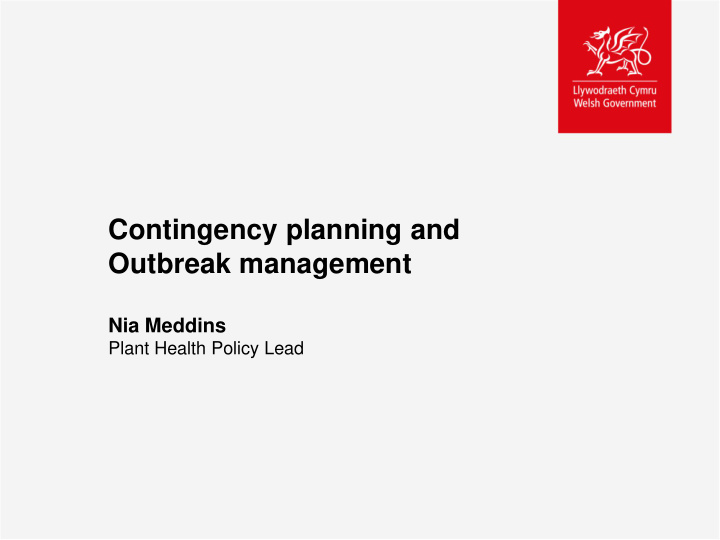



Contingency planning and Outbreak management Nia Meddins Plant Health Policy Lead
What does contingency planning involve? The contingency planning process can basically be broken down into three simple questions: • What is going to happen? • What are we going to do about it? • What can we do ahead of time to get prepared?
Potential Challenges Ahead…. Pests & Diseases..
Benefits of Contingency Planning • Allow a quicker response. • Allows time to think through different options. • A tool for making stakeholders aware of and give stakeholders a chance to influence what action may be taken. • Can highlight gaps in current arrangements; e.g. The lack of pesticide approvals
Questions for contingency plans • Why? - explanation of why action is necessary. • Who? – which people / agencies will be responsible and how will they co-ordinate. • What? – actions to be taken – communication, surveys, pest management, movement restrictions. • When? – how quickly to take actions, time of year to take them and how long they will last for. • How? – equipment needed, protocols, training.
• Generic Contingency Plan Outlines general arrangements and organisation to deal with an outbreak of any major pest. • Pest Specific Contingency Plan Specific information and guidance on how to deal with a particular major pest. • Incident Action Plans How a team is going to respond to a particular outbreak. i.e. What tasks are to be done, who is going to do them and when they are going to be done by.
Generic contingency plans can be used to: • Describe the legal basis for taking action against pests. • Give the reasons why we need to take action to eradicate or contain pests. • Give details of the agencies that are responsible for eradication action in a country. • Describe how these agencies work together and what their different responsibilities are.
What should be in a generic Plant Health plan? • Initiation of a plan including official action on a presumptive diagnosis • Official actions to eradicate the pest after final diagnosis • Review of measures in case of prolonged official action • Command structure • Stakeholder consultation • Internal communications and documentation • External communications • Testing and training personnel • Evaluation and revision of contingency plan
Multi Agency Approach - Operational management of tree health in wales - Management of the impact of pests and diseases is a key role. - co-ordination of UK policy - International representation - Administers UK PH risks register - Participate in UK decision making - - Devolved implementation - Participate in UK - Diagnostics for decision making England and Wales - Forestry/wood -inspectorate for implementation England and Wales
Generic Elements? Initiation of the plan • How serious is the finding? • What information needs to be collected straight away? • Who would triage the finding? Command Structure • Who’s in charge • Roles & responsibilities • Documentation • Evaluation
How Serious is a finding?
Triaging? • An ad hoc group put together quickly in response to a notification composed of Plant Health Service (PHS) officials and specialists, as appropriate. • The group will assess the report using a set of standard questions. • If the alert status is confirmed as either Black, Amber or Red the as decision will be taken to nominate the control authority, decide on command level and indicate the scale of response required.
https://planthealthportal.defra.gov.uk/
Definitions The five basic terms to describe a type of exercise are: • Workshops • Drill/Training • Table top • Functional • Full-Scale
Workshops • A low stress, non-threatening event that does not follow real time • Tends to concentrate on process related issues and with the focus on training and familiarisation of roles and responsibilities • It is designed to elicit constructive discussion • The general purpose is to introduce plans, policies, procedures and start resolving questions of coordination and responsibility
Drill/Training • Designed to test, develop and maintain skills in an emergency response function • They often have an office or field component and may be driven by a simple scenario
Table Top • An informal discussion using a simple simulated scenario • There is no time pressure although the technique of scenario time jumps may be used • The purpose is to evaluate plans, policies, procedures and to resolve questions of coordination and responsibility
Functional • More advanced rehearsals and table tops, usually in preparation for full-scale exercises • Emergency response tasks and functions will be rehearsed and tested and may include the establishment of an Incident Management Team and Emergency Operations Centre but this will not involve a full mobilisation • They are realistic, tend to take place in real time and are often stressful • May include Operational Partners and Stakeholders
Full-Scale • Intended to thoroughly test and evaluate contingency plans, procedures and instructions and the emergency operational capability of the organisation • It will include using Incident Management Systems in an interactive manner and will run over a substantial period of time • It is driven by a detailed scenario with a supporting data set and results in a highly realistic and often stressful exercise environment
Recommend
More recommend